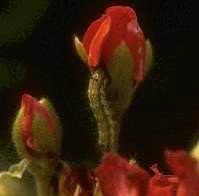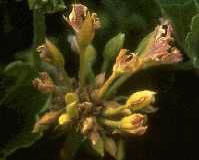 Budworms
may not rival the man-eating plant in the play "Little
Shop of Horrors"; but if you grow certain annuals, you
may find them just as terribly destructive. If you
like growing geraniums, petunias, snapdragons,
penstemon, angelonia, nicotiana and many others, you
are growing flowers that budworms love to eat. The
budworm is a real threat to tobacco crops, too;
fortunately for tobacco farmers they have more potent
pesticides and better training in using them than the
ordinary gardener.
Budworms
may not rival the man-eating plant in the play "Little
Shop of Horrors"; but if you grow certain annuals, you
may find them just as terribly destructive. If you
like growing geraniums, petunias, snapdragons,
penstemon, angelonia, nicotiana and many others, you
are growing flowers that budworms love to eat. The
budworm is a real threat to tobacco crops, too;
fortunately for tobacco farmers they have more potent
pesticides and better training in using them than the
ordinary gardener.
I discovered these worms (also
known as the geranium/petunia budworm) last summer in
my petunias. I had planted Tidal Wave Silver petunias
that had nicely covered a large gardening space.
Unfortunately, I soon noticed holes near the flower
bases and upon inspection found the worms inside the
flowers. Some researching told me I had budworms.
Another hint that budworms are present are small black
spots on the leaves and flowers. This is frass (or
worm poop).
 I
tried to keep the budworms in check by spraying and
squeezing them. When the worms got ahead of me and
made a mess of the petunias, I pulled them out and
threw them away. This year I decided to replace the
petunias with snapdragons and angelonia and hoped that
would put me in the clear. Both now have budworms,
possibly coming along with the plants when I purchased
them from the greenhouse, an interesting fact I
discovered while doing some reading.
I
tried to keep the budworms in check by spraying and
squeezing them. When the worms got ahead of me and
made a mess of the petunias, I pulled them out and
threw them away. This year I decided to replace the
petunias with snapdragons and angelonia and hoped that
would put me in the clear. Both now have budworms,
possibly coming along with the plants when I purchased
them from the greenhouse, an interesting fact I
discovered while doing some reading.
Budworms also like geraniums,
and they have already appeared on my geranium buds. I
must blame myself for this because now I’m learning
that bringing geraniums in for the winter without
changing the soil first can be to blame. But who knew?
I have brought geraniums in for the winter for years
and never had problems. (Budworm 2 – Geranium blossom
devastated by budworms)
Apparently, the biggest factor
in the increase in the budworm population is the warm
winter we had last year. The insect spends the winter
as a pupa about 2 to 6 inches deep in the soil within
a packed earthen cell. Even in a very cold winter, the
insect can live in a protected area of the soil such
as next to a sun-warmed wall or foundation. If the
temperature does not drop below 20 degrees, the insect
will most likely live and emerge in the spring as an
adult in the moth form. The moth has a wingspan of
about 1 1/2 inches; the wings are light colored with
brown overtones and a few wavy cream colored bands.
You may see it flying up from the grass in the
evening. (Budworm 1 – Notice how the budworm’s color
mimics the geranium stem)
 Eggs
are laid singly, during early evening, on geranium
buds or on leaves of other plants. The larvae that
emerge are tiny worms that immediately begin to eat.
At this point you may notice some problems--holes in
flower buds, ragged blossoms, or no blossoms. As the
worm eats, it gets bigger and more noticeable. An
interesting factor here is that the worm may take on
the color of the flower it is eating. So a purple
angelonia will produce a purple worm, a green
undeveloped geranium bud, a green worm, a white
snapdragon bloom, a white worm, etc. By the way, you
may have to squeeze open the snapdragon blossom to see
the worm inside.
Eggs
are laid singly, during early evening, on geranium
buds or on leaves of other plants. The larvae that
emerge are tiny worms that immediately begin to eat.
At this point you may notice some problems--holes in
flower buds, ragged blossoms, or no blossoms. As the
worm eats, it gets bigger and more noticeable. An
interesting factor here is that the worm may take on
the color of the flower it is eating. So a purple
angelonia will produce a purple worm, a green
undeveloped geranium bud, a green worm, a white
snapdragon bloom, a white worm, etc. By the way, you
may have to squeeze open the snapdragon blossom to see
the worm inside.
If you suspect that you have
budworms, look for them in the early evening. Once you
see the holes, keep looking and soon you will see the
worm itself. Budworms are found all over the <?xml:namespace
prefix = st1 ns = "urn:schemas-microsoft-com:office:smarttags"
/ US, and they can produce two or more generations a
year. Hand-picking should be done in the home garden.
Tobacco budworm is resistant
to most garden insecticides. In addition, using them
may kill beneficial insects such as wasps, bigeye bug,
damsel bugs, minute pirate bugs, and spiders. If you
use an insecticide, look for one with synthetic
pyrethrins also known as pyrethoid insecticides. The
insecticide known as Bt may be effective on some
plants. However, the insect must eat the Bt in order
for it to be effective. If the worms have drilled into
the bud, they are not eating the Bt. Keep weeds in
check by pulling, since the weeds can also be hosts
for the budworm.
Another possible remedy for
getting rid of budworms would be to rototill your
planting areas. Working the soil in the fall is
preferable, but spring tilling may crush some of the
budworm pupa.
In the fall remember to throw
away the soil from potted plants and replace with new
potting mixture if you are over wintering plants. Be
mindful that any flowers and buds you put in your
compost pile may have budworms that will over winter
to continue your problem next year. And hope for a
very cold winter!
For more information search
for geranium/petunia budworm on the Internet and use
information from educational sites such as state
universities.
Read other articles about controlling insects & garden pests